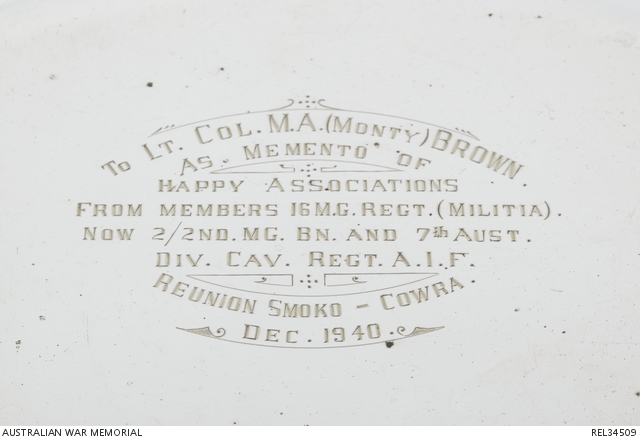| Place | Oceania: Australia, New South Wales, Cowra |
|---|---|
| Accession Number | REL34509 |
| Collection type | Heraldry |
| Object type | Heraldry |
| Physical description | Ebonite, Electo Plated Nickel Silver (EPNS) |
| Maker |
Hecworth |
| Date made | c 1940 |
| Conflict |
Second World War, 1939-1945 |
Silver presentation dish : Lieutenant Colonel M A Brown, 16 Machine Gun Regiment (Militia)


Oval shaped electro plated nickel silver dish with lid. The lid has a pair of 70 mm long by 10 mm diameter ebonite handles attached at either end. The handles are attached to the lid by a pair of electro plated nickel silver arms. On top of the lid is engraved 'TO LT. COL. M.A. (MONTY) BROWN / AS MOMENTO OF / HAPPY ASSOCIATIONS / FROM MEMBERS 16 M.G. REGT. (MILITIA). / NOW 2/2ND. MG. BN. AND 7th AUST. / DIV. CAV. REGT. A.I.F. / REUNION SMOKO - COWRA / DEC. 1940.' The lip of the base has a small dent on one side. Further along this lip on the reverse is stamped 'HECWORTH / E.P
This presentation dish is associated with the Second World War service of Montague Ambrose 'Monte' Brown. Brown was born near Bega, NSW in 1899 and was educated at St Joseph's College, Hunters Hill. On leaving school he returned to the New South Wales south coast where he was active in the pre-war Australian Army militia, serving with 1 Light Horse as a trooper from 31 December 1909. On 1 April 1910 he was promoted to corporal and three months later to sergeant. In July 1912 he transferred to 28 Light Horse where he promoted to regimental sergeant major on 1 January 1913. Brown was offered a commission to 2nd lieutenant on 1 August 1913.
With the declaration of war in 1914 he was an early volunteer in the AIF. However, upon joining he reverted to the rank of trooper. He left Sydney in 1915 with the 12th Light Horse, bound for Egypt. The AIF eventually recognised his experience with the militia and on 4 May 1915 Brown was promoted to 2nd lieutenant. He was then dispatched to Gallipoli with his regiment where he was promoted to full lieutenant on 19 August 1915. With the end of the Gallipoli campaign, Brown returned to Egypt with his unit.
Brown served in Egypt and Palestine and on 9 September 1916 was promoted to the rank of captain. In 1917 he was transferred to the Indian Army for a five year engagement with the Imperial Government. During his time in India he served as a captain with 9 Hodson's Horse Cavalry Regiment and saw active service during the third Anglo-Afghan war between May and August 1919. On 8 November 1922 Brown's period of service with the Indian Army ended and he returned to Australia.
During the 1930s he lived in western NSW, and also spent time in the Hunter Valley. Brown served as a major with 16 Light Horse between December 1926 and August 1935. While with this regiment he was a Commanding Officer of 16 'Hunter River Lancers' Light Horse Regiment, with its Headquarters in East Maitland. After service with this unit he transferred to the 16 Machine Gun Battalion.
Considered too old for active service upon the declaration of the Second World War in September 1939,his first posting saw him first serve at the Prisoner of War and internment camp at Berrima in the Southern Highlands of NSW. After this posting he became the Group Commandant of the 22nd Garrison Battalion at the newly built Prisoner of War Camp No.12 at Cowra NSW. During his time at Cowra, the infamous 'Cowra breakout' occurred on the night of 5 August 1944. Brown left the military in 1947 and passed away in 1975.
Share this page
Related information
Conflicts
Units
Subjects
Related Objects
- White tropical helmet : Captain M A Brown 9 Hodson's Horse Cavalry Regiment, British Indian Army
- Trench art miniature ice pick, Cowra Prisoner of War Camp : Lieutenant Colonel M A Brown, 22 Garrison Battalion
- Compass and leather case : Captain M A Brown, 12 Light Horse Regiment, AIF
- Identity disc : Lieutenant M A Brown, 12 Light Horse Regiment, AIF
- Fob watch : Lieutenant M Byrne, Queen Alexandra's Imperial Military Nursing Service Reserve
- Queen Alexandra's Imperial Nurses Reserves Badges : Lieutenant M Byrne, Queen Alexandra's Imperial Military Nursing Service Reserve
- Qualification badge : Lieutenant M Byrne, Queen Alexandra's Imperial Military Nursing Service Reserve
- Shawl : Lieutenant M A Brown, 12 Light Horse Regiment, AIF
- Calico bag : Lieutenant M A Brown, 12 Light Horse Regiment, AIF
- Indigo and gold bullion length of fabric : Captain M A Brown, 12 Light Horse Regiment, AIF